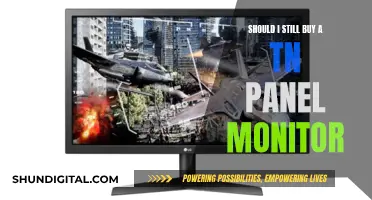
G-Sync is a technology developed by Nvidia to provide a variable refresh rate (VRR) for tear-free gameplay. It works by synchronizing the refresh rates of a monitor to the frame rates of a GPU. This eliminates screen tearing and stuttering, which can cause a distracting and unsatisfactory gaming experience. G-Sync is a special chip installed inside a G-Sync monitor that replaces the traditional scaler, and it comes with a premium due to the additional hardware required.
G-Sync ultimately aims to provide maximum performance, minimal latency, and no tearing. However, it is not compatible with AMD graphics cards and is locked to Nvidia GPUs. This is a significant consideration when deciding whether G-Sync is worth the investment, as it limits flexibility in system configuration.
So, does G-Sync reduce performance? The short answer is no. G-Sync is designed to enhance performance by providing a smooth and immersive gaming experience without the issues of screen tearing and stuttering. However, it is important to note that G-Sync comes at a higher price point, and there are alternative technologies, such as AMD's FreeSync, that offer similar variable refresh rate capabilities.
| Characteristics | Values |
|---|---|
| Synchronization Technology | G-Sync was designed to be used with V-Sync, but Nvidia later allowed people to turn this option off. |
| Screen Tearing | G-Sync eliminates screen tearing by synchronizing the monitor's refresh rate to the GPU's frame rate output. |
| Stuttering | G-Sync reduces stuttering by dynamically changing the monitor's refresh rate to match the GPU's frame rate. |
| Input Lag | G-Sync reduces input lag by providing a variable refresh rate and variable overdrive. |
| Performance | G-Sync improves performance by matching the monitor's refresh rate to the GPU's frame rate, eliminating screen tearing and reducing stuttering and input lag. |
| Price | G-Sync monitors are typically more expensive due to the proprietary hardware required to support Nvidia's version of adaptive refresh. |
| Compatibility | G-Sync is only compatible with Nvidia graphics cards. AMD graphics cards use a different technology called FreeSync. |
What You'll Learn

G-Sync vs. FreeSync
G-Sync and FreeSync are technologies developed by Nvidia and AMD, respectively, to address the issue of screen tearing—when the refresh rate of your monitor is not synchronized with the frame rate of the game you're playing. Both technologies dynamically change the refresh rate of the monitor in real time to match the frame rate of the content being displayed, thus eliminating screen tearing.
G-Sync vs FreeSync: Price
G-Sync monitors are generally more expensive than FreeSync monitors because they require a specific hardware module from Nvidia to be installed. FreeSync, on the other hand, does not incur additional hardware costs as it works natively over DisplayPort 1.2 and newer. This means your GPU needs a DP 1.2 or newer output, and you need to use a DP 1.2 or newer cable.
G-Sync vs FreeSync: Compatibility
The G-Sync module ensures that G-Sync monitors will eliminate screen tearing even when used with older GPUs. FreeSync, on the other hand, is only compatible with AMD GPUs from the RX 200 series onwards.
G-Sync vs FreeSync: Variable Refresh Rate Range
G-Sync monitors typically have a wider variable refresh rate (VRR) range than FreeSync monitors. For example, a 144Hz G-Sync gaming monitor has a VRR range of 30-144Hz, while a similar FreeSync monitor will usually have a dynamic range of 48-144Hz. This means that if your frame rate drops to 40 FPS, a G-Sync monitor will change its refresh rate to 40Hz, while a FreeSync monitor will have to resort to Low Framerate Compensation (LFC) and multiply its refresh rate to 120Hz, causing minor stuttering.
G-Sync vs FreeSync: Input Lag
G-Sync monitors have lower input lag than FreeSync monitors because the G-Sync module replaces the regular scaler in the monitor. However, most FreeSync monitors have imperceptibly low input lag anyway.
G-Sync vs FreeSync: Overall
Whether G-Sync is worth the extra cost depends on your specific use case. In some cases, for the price difference between a G-Sync monitor and its FreeSync counterpart, you could simply buy a better display with FreeSync/G-Sync Compatible. Additionally, there are some FreeSync/G-Sync Compatible monitors that have just as wide of a VRR range and similarly good overdrive implementations as G-Sync models. Therefore, for most people, either technology will be fine, as the specific advantages and drawbacks of each one are not likely to be dealbreakers.
Mounting Your ASUS ROG Monitor: A Stand Setup Guide
You may want to see also

G-Sync Compatible Monitors
The main advantage of G-Sync Compatible monitors is their lower price compared to regular G-Sync monitors. This is because they don't require the dedicated G-Sync module, which increases the cost of regular G-Sync monitors. G-Sync Compatible monitors are also more widely available and offer more extensive connectivity options.
However, regular G-Sync monitors usually have a wider variable refresh rate range, and their overdrive implementation is generally better. They also offer lower input lag due to the dedicated G-Sync module replacing the regular scaler in the monitor.
So, is G-Sync Compatible worth it? It depends on your specific use case and budget. If you're looking for a budget-friendly option and don't mind a slightly narrower variable refresh rate range, then a G-Sync Compatible monitor could be a good choice. On the other hand, if you're seeking the best possible performance and have the budget for it, a regular G-Sync monitor might be a better option. Ultimately, the decision depends on your personal preferences and requirements.
Blind Spot Monitoring: Is It Available on the BRZ?
You may want to see also

G-Sync Ultimate Monitors
While G-Sync Ultimate monitors offer exceptional performance and image quality, they also come with a higher price tag. The dedicated module increases the monitor's cost compared to FreeSync or G-Sync Compatible alternatives, which are based on royalty-free Adaptive-Sync protocols. Additionally, G-Sync Ultimate monitors may have limited connectivity options and require a compatible NVIDIA graphics card to utilise the G-Sync technology.
When considering a G-Sync Ultimate monitor, it is essential to evaluate your specific needs, budget, and available alternatives. While G-Sync Ultimate offers superior performance and features, there are cases where Adaptive-Sync counterparts can provide a comparable experience at a more affordable price.
Asus Monitors: Refresh Rates and Hertz Explained
You may want to see also

G-Sync and Budgeting
When it comes to G-Sync and budgeting, there are a few things to consider. G-Sync is a technology developed by NVIDIA that synchronizes the refresh rates of a monitor to the frame rates of a GPU, eliminating screen tearing and stuttering. While G-Sync can provide a smoother gaming experience, it can also increase the price of a monitor. Here are some factors to consider when deciding if G-Sync is worth the investment:
Budget:
The first thing to consider is your budget. G-Sync monitors tend to be more expensive than their non-G-Sync counterparts. If you have a limited budget, you may need to prioritize other features such as resolution, refresh rate, or panel type over G-Sync. It's important to weigh the benefits of G-Sync against the cost to determine if it's a worthwhile investment for you.
Type of Games:
The type of games you play can also impact whether G-Sync is worth the investment. If you play fast-paced games that require quick reactions, such as first-person shooters or esports games, G-Sync can provide a smoother and more responsive experience. On the other hand, if you play slower-paced games or games that don't require quick reactions, the benefits of G-Sync may not be as noticeable.
PC Configuration:
Your PC configuration can also play a role in your decision. If you have a powerful GPU that can take advantage of high refresh rates and frame rates, G-Sync can be a worthwhile investment. However, if you have a lower-end GPU that struggles to maintain high frame rates, you may not see the full benefits of G-Sync.
Alternative Technologies:
It's important to note that there are alternative technologies to G-Sync, such as AMD's FreeSync, that provide similar benefits at a lower cost. FreeSync monitors don't have the dedicated G-Sync module, which helps keep costs down. While FreeSync may not offer the same level of performance as G-Sync in some cases, it can still provide a significant improvement over non-adaptive sync displays.
Resolution and Refresh Rate:
The resolution and refresh rate you're aiming for can also impact whether G-Sync is worth the investment. For example, if you're looking for a 1080p display, G-Sync monitors may not offer a significant enough improvement over FreeSync or non-adaptive sync monitors to justify the extra cost. On the other hand, if you're looking for a high-end 1440p or 4K monitor with a high refresh rate, G-Sync may be a worthwhile investment to get the best possible performance.
Panel Type:
The type of panel you prefer can also be a factor in your decision. G-Sync is available on various panel types, including IPS, TN, and VA. Each panel type has its own advantages and disadvantages in terms of colour accuracy, response time, and viewing angles. It's important to consider which panel type is most important to you and whether G-Sync is available on those monitors within your budget.
In conclusion, when it comes to G-Sync and budgeting, it's important to consider your budget, the type of games you play, your PC configuration, alternative technologies, the resolution and refresh rate you're aiming for, and the panel type you prefer. G-Sync can provide a smoother and more responsive gaming experience, but it may not be worth the investment for everyone. It's essential to weigh the benefits against your budget and priorities to make an informed decision.
Setting Up Your Alienware Curved Monitor: A Step-by-Step Guide
You may want to see also

G-Sync vs. V-Sync
G-Sync and V-Sync are both technologies designed to improve the gaming experience by reducing screen tearing. However, they work in different ways and offer varying levels of performance and compatibility.
V-Sync (Vertical Synchronization)
V-Sync is a software setting that can be enabled or disabled within a game. It works by forcing the graphics hardware to match the refresh rate of the display, thereby reducing screen tearing. This is effective in preventing screen tearing but has some drawbacks. Firstly, it limits the frame rate to the display's refresh rate, which can affect performance, especially in games that require high frame rates. Additionally, V-Sync can introduce input lag, which can be problematic for games that demand precision, such as rhythm or fighting games. It can also cause issues when displaying videos or movies filmed at slower frame rates, creating a juddering effect.
G-Sync
G-Sync, on the other hand, is a hardware solution built into certain monitors. It allows for a dynamic refresh rate that matches the output from the graphics card, eliminating screen tearing without limiting the frame rate. G-Sync provides a smoother gaming experience with minimal input lag. However, it requires a compatible monitor and graphics card, which can be more expensive. G-Sync also has different variations, such as G-Sync Ultimate, which guarantees the elimination of screen tearing.
Comparison
In terms of performance, G-Sync is generally considered superior to V-Sync due to its ability to eliminate screen tearing without sacrificing frame rate. However, G-Sync requires additional hardware investment, while V-Sync is a free software setting. For gamers who play fast-paced or competitive games that require high frame rates and low input lag, G-Sync is often the preferred choice. For more casual gamers or those on a budget, V-Sync can still provide an adequate gaming experience, especially if screen tearing is not a major issue.
Additionally, it is worth noting that both technologies have their own variations, such as Adaptive V-Sync and Fast Sync for V-Sync, and G-Sync Ultimate for G-Sync, which offer enhanced features and improvements. When deciding between the two, it is important to consider the type of games played, the desired performance level, and the budget available for hardware upgrades.
Camera Location on ASUS Monitors: A Quick Guide
You may want to see also
Frequently asked questions
G-Sync is designed to improve performance by eliminating screen tearing and stuttering. It does this by synchronizing the refresh rates of a monitor to the frame rates of a GPU.
G-Sync is a technology developed by Nvidia that synchronizes the refresh rates of a monitor (Hz) to the frame rates of a GPU (FPS) to eliminate screen tearing and stuttering.
G-Sync improves gaming performance by providing a smooth, tear-free experience. It does this by matching the monitor’s refresh rate to the GPU’s frame rate output, resulting in an immersive gaming experience.
G-Sync eliminates screen tearing and reduces input lag. However, it can be expensive and is only compatible with Nvidia graphics cards.







